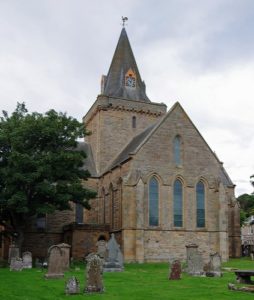Few people visited Dornoch Cathedral, until Madonna chose to have her son christened here. Now it is a popular stop on the tourist route.
Dornoch cathedral is set in a walled grassy kirkyard in the centre of Dornoch. Outside the wall is a splendid painted fountain given by Miss Georgina Anderson in 1892.
It is a small cross shaped 13thC building of red sandstone with steep roofs and a small central tower with a short stumpy spire. It is a very plain building apart from corbelling around the top of the tower. The building was started by Gilbert de Maravia, Bishop of Caithness who decided to move the see from Halkirk in the north of Sutherland to Dornoch. He was buried under the crossing.
The cathedral was set on fire in 1570 during a clan feud between the Murrays of Dornoch and the MacKays of Strathnaver. This destroyed the nave, the roof of the rest of the building and Gilbert’s tomb was desecrated. The choir and transepts were repaired and reroofed in 1616 and a wall was built to shut off the remains of the nave. The nave was finally rebuilt in 1835-7, funded by Elizabeth, Duchess-Countess of Sutherland.
Steps lead up to the simple south door. A notice says disabled access is via the north door, but this was locked when we visited. Inside the porch are information leaflets in a dozen different languages, although they had run out of English ones.
Inside the walls are bare stone as the lath and plaster of the Victorians was removed in 1924. This also revealed two of the original pillars in the wall to the west of crossing. There are stone wall pillars and pointed stone arches above the transept crossing. The pale cream plaster ceiling was painted for the Christening of Madonna’s son Rocco in 2000 and still looks very smart with its carved bosses.
The tall lancet windows contain 19thC glass. In the choir three windows on the north wall commemorate Andre Carnegie who stayed at nearby Skibo Castle every year. He paid for the renovation of the large organ in the north transept. On the south wall is a modern stained glass window of Bishop Gilbert installed in 1989 on the 750th Anniversary of the consecration of the cathedral, and consecrated in the presence of Prince Charles in his role of Duke of Rothsay.
In the south transept is a memorial window to the dead of World War One.
There is a carved wood pulpit, stone font and carved wood altar front.
At the back of the nave is the sarcophagus of St Richard de Moravia, brother of Gilbert, who was killed in battle about 1240.
It is a rather plain and uninspiring building inside. We were disappointed by it. It can also get busy with tourists and especially coach tours.



